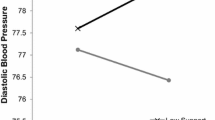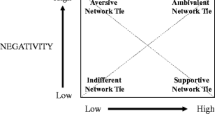Abstract
Cardiovascular reactivity (CVR) has been identified as a potential mechanism linking a variety of psychosocial processes to the development of cardiovascular disease. Although the effects of hostile and supportive social stimuli on CVR have been studied extensively, less in known about the effects of a second major dimension of social relations—dominance versus submissiveness. In the present study, 45 married couples participated in an interaction task involving the assertion of differing opinions. Subjects also provided ratings of their typical level of dominance versus submissiveness in relation to their spouse. Consistent with predictions derived from related conceptual models of psychological determinants of CVR, blood pressure reactivity was positively associated with perceptions of the spouse as dominant. At the highest level of perceived spouse dominance, CVR was attenuated, again consistent with prediction. Results are discussed in terms of the usefulness of conceptual models of interpersonal relations and motivation as guides in studying the social determinants of CVR, as well as the value of marital interactions as a context for understanding CVR.
Similar content being viewed by others
References
Manuck SB: Cardiovascular reactivity in cardiovascular disease: “Once more unto the breach.”International Journal of Behavioral Medicine. 1994,1: 4–31.
Turner JR:Cardiovascular Reactivity and Stress: Patterns of Physiological Response. New York: Plenum Press, 1995.
Ballard ME, Cummings EM, Larkin KT: Emotional and cardiovascular responses to adults' angry behavior and to challenging tasks in children of hypertensive and normotensive parents.Child Development. 1993,64: 500–515.
Edens JL, Larkin KT, Abel JL: The effect of social support and physical touch on cardiovascular reactions to mental stress.Journal of Psychosomatic Research. 1992,36: 371–382.
Heiden LA, Larkin KT, Knowlton GE: Cognitive response to a cold pressor challenge in high and low blood pressure reactive subjects.Journal of Psychosomatic Research. 1991,35: 679–685.
Larkin KT, Zayfert C, Veltum LG, Abel JL: Effects of feedback and contingent reinforcement in reducing heart rate response to stress.Journal of Psychophysiology. 1992,6: 119–130.
Semenchuk EM, Larkin KT: Behavioral and cardiovascular responses to interpersonal challenges among male offspring of essential hypertensives.Health Psychology. 1993,12: 416–419.
Larkin KT, Frazer NL, Semenchuk EM: Physiological, affective, and behavioral responses to interpersonal conflict among males from families with different levels of cohesion and adaptability.Journal of Psychopathology and Behavioral Assessment. 1996,18: 239–254.
Larkin KT, Zayfert C: Anger management training with mild essential hypertensive patients.Journal of Behavioral Medicine. 1996,19: 415–433.
Brown PC, Smith TW: Social influence, marriage, and the heart: Cardiovascular consequences of interpersonal conflict in husbands and wives.Health Psychology. 1992,11: 88–96.
Ewart CK, Kolodner KB: Social competence interview for assessing physiological reactivity in adolescents.Psychosomatic Medicine. 1991,53: 289–304.
Ewart CK, Taylor CB, Kramer HC, Agras SW: High blood pressure and marital discord: Not being nasty matters more than being nice.Health Psychology. 1991,10: 155–163.
Holroyd KA, Gorkin L: Young adults at risk for hypertension: Effects of family history and anger management in determining responses to interpersonal conflict.Journal of Psychosomatic Research. 1983,27: 131–138.
Morrison RL, Bellack AS, Manuck SB: Role of social competence in borderline essential hypertension.Journal of Consulting and Clinical Psychology. 1985,53: 248–255.
Smith TW, Brown PC: Cynical hostility, attempts to exert social control, and cardiovascular reactivity in married couples.Journal of Behavioral Medicine. 1991,14: 581–592.
Frazer NL, Larkin KT, Robyn S, et al: Relation between family environment and cognitive and physiological response to stress. InProceedings of the Fourth International Congress of Behavioral Medicine Rockville, MD: Society of Behavioral Medicine, 1996, S148.
Suchday S, Larkin KT, Schauss S, et al: Cardiovascular and cognitive response to anger expression and anger suppression in anger-in and anger-out males.Annals of Behavioral Medicine. 1995,17(Suppl.):S120.
Suls J, Wan CK: The relationship between trait hostility and cardiovascular reactivity: A quantitative review and analysis.Psychophysiology. 1993,30:615–626.
Muldoon MF, Terrell DF, Bunker CH, Manuck SB: Family history studies in hypertension research: Review of the literature.American Journal of Hypertension. 1993,6:76–88.
Glass CR, Merluzzi TV, Biever JL, Larsen KH: Cognitive assessment of social anxiety: Development and validation of a selfstatement questionnaire.Cognitive Therapy and Research. 1982,6:37–55.
Spielberger CD:State-Trait Anger Expression Inventory: Professional Manual Odessa, FL: Psychological Assessment Resources, 1988.
Spielberger CD, Gorsuch RL, Lushene R:State-Trait Anxiety Inventory. Palo Alto, CA: Consulting Psychologists Press, 1970.
Hops H, Mills TA, Patterson GR, Weiss RL:Marital Interaction Coding System. Eugene, OR: Oregon Research Institute, 1972.
Turner SM, Beidel DC, Larkin KT: Situational determinants of social anxiety in clinic and nonclinic samples: Physiological and cognitive correlates.Journal of Consulting and Clinical Psychology 1986,54:523–527.
Beidel DC, Turner SM, Dancu CV: Physiological, cognitive, and behavioral aspects of social anxiety.Behavioral Research and Therapy. 1985,23:109–117.
Turner JR, Hewitt JK: Twin studies of cardiovascular reactivity to psychological challenge: A review and suggested future directions.Annals of Behavioral Medicine. 1992,14:12–20.
Baer PE, Vincent J, Williams BJ, et al: Behavioral response to induced family conflict in families with a hypertensive father.Hypertension. 1980,2:70–77.
Baer PE, Reed J, Barlett PC, et al: Studies of gaze during induced conflict in families with a hypertensive father.Psychosomatic Medicine. 1983,45:233–242.
Krause AM, Long BC: Predictors of coping from mothers of separated/divorced offspring.Canadian Journal on Aging. 1993,12:50–66.
Waldren T, Bell NJ, Peek CW, Sorell G: Cohesion and adaptability in post-divorce, remarried, and first married families: Relationships with family stress and coping styles.Journal of Divorce and Remarriage. 1990,14:13–28.
Olson DH, Portner J, Bell R:EACES II: Family Adaptability and Cohesion Scales. St. Paul, MN: University of Minnesota, 1982.
Olson DH: Family measurement techniques.American Journal of Family Therapy. 1985,13: 76–78.
Suchday S, Desiderato O: Factor analysis of an anger cognitions inventory. The 13th Annual Meeting of the Society for Behavioral Medicine. New York: 1991.
Woodall KL, Matthews KA: Familial environment associated with Type A behaviors and psychophysiological responses to stress in children.Health Psychology. 1989,8:403–426.
Wright LB, Treiber FA, Davis H, et al: Relationship between family environment and children's hemodynamic response to stress: A longitudinal evaluation.Behavioral Medicine. 1993,19:115–121.
Smith TW, Allred KD, Morrison CA, Carlson SD: Cardiovascular reactivity and interpersonal influence: Active coping in a social context.Journal of Personality and Social Psychology. 1989,56:209–218.
Smith TW, Baldwin M, Christensen AJ: Interpersonal influence as active coping: Effects of task difficulty on cardiovascular reactivity.Psychophysiology. 1990,27:429–437.
Christensen AJ, Smith TW: Cynical hostility and cardiovascular reactivity during self-disclosure.Psychosomatic Medicine. 1993,55:193–202.
Burns JW, Katkin ES: Psychological, situational, and gender predictors of cardiovascular reactivity to stress: A multivariate approach.Journal of Behavioral Medicine. 1993,16:445–465.
Suarez EC, Harlan E, Peoples MC, Williams RB: Cardiovascular and emotional responses in women: The role of hostility and harassment.Health Psychology. 1993,12:459–468.
Lassner JB, Matthews KA, Stoney CM: Are cardiovascular reactors to asocial stress also reactors to social stress.Journal of Personality and Social Psychology. 1994,66:69–77.
Author information
Authors and Affiliations
About this article
Cite this article
Brown, P.C., Smith, T.W. & Benjamin, L.S. Perceptions of spouse dominance predict blood pressure reactivity during marital interactions. ann. behav. med. 20, 286–293 (1998). https://doi.org/10.1007/BF02886378
Published:
Issue Date:
DOI: https://doi.org/10.1007/BF02886378




